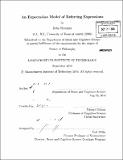An expectation model of referring expressions
Author(s)
Kræmer, John, Ph. D. Massachusetts Institute of Technology
DownloadFull printable version (13.17Mb)
Alternative title
EMRE
Other Contributors
Massachusetts Institute of Technology. Dept. of Brain and Cognitive Sciences.
Advisor
Edward Gibson.
Terms of use
Metadata
Show full item recordAbstract
This thesis introduces EMRE, an expectation-based model of referring expressions. EMRE is proposed as a model of non-syntactic dependencies - in particular, discourse-level semantic dependencies that bridge sentence gaps. These include but are not limited to anaphora (references to noun phrases in previous sentences) and coherence predicates such as causality, temporal ordering and resemblance -- two domains that have typically been treated as entirely distinct aspects of language. EMRE is a computational-level model, and is agnostic about any particular algorithms, cognitive faculties, or neurological substrates that might be applied to the problem of semantic reference. Instead, it describes reference as a computational problem framed in terms of expectation and inference, and describes a solution to the problem based on rational top-down expectations about the likely targets of referring expressions, and on bottom-up feature-based matching that occurs when a referring expression is encountered. EMRE is used to derive novel empirical predictions about how people will construe particular discourse constructions involving NP anaphora and coherence predicates. These predictions are tested in controlled behavioral experiments, in which participants read and answer questions about short texts. The results of these experiments are shown to be consistent with a model of reference as an expectation-based computational structure with different underlying rules than those governing syntactic processing.
Description
Thesis (Ph. D.)--Massachusetts Institute of Technology, Dept. of Brain and Cognitive Sciences, 2010. Cataloged from PDF version of thesis. Includes bibliographical references (p. 297-205).
Date issued
2010Department
Massachusetts Institute of Technology. Department of Brain and Cognitive SciencesPublisher
Massachusetts Institute of Technology
Keywords
Brain and Cognitive Sciences.